The Evolution and Future Prospects of China’s Wave Energy Policy from the Perspective of Renewable Energy: Facing Problems, Governance Optimization and Effectiveness Logic
Abstract
1. Introduction
2. Materials and Methods
2.1. The Data Source
2.1.1. Academic Literature Retrieval
2.1.2. Policy-Text Retrieval
2.2. Research Methods
2.3. Research Steps
2.3.1. Literature-Visualization Analysis
2.3.2. Visual Analysis of Policy Texts
3. Literature-Visualization Analysis
3.1. General Situation
3.1.1. Overall Number of Publications
3.1.2. Information about the Author and the Institution
3.2. Research Hotspots
3.2.1. Keyword Co-Occurrence Analysis
3.2.2. Keyword-Cluster Analysis
3.2.3. Keyword-Emergence Analysis
3.2.4. Analysis of Highly Cited Literature
3.3. Research Context
4. Visual Analysis of China’s Wave-Energy Policy Text
4.1. Policy-Development Trend
4.2. Word-Frequency Analysis of Policy Content
4.3. Analysis of Policy-Text Coding
4.4. Comparative Analysis of Key Policies
5. Conclusions
6. Contributions
- Identifies the current state of cooperation in the area of wave-energy policy and the most productive institutions and individuals;
- Identifies major research topics in the area of wave-energy policy;
- Discusses the turning point of wave-energy policy evolution;
- Points out the weakness of China’s wave-energy policy;
- Clarifies the direction of wave-energy policy formulation in the future.
Author Contributions
Funding
Institutional Review Board Statement
Informed Consent Statement
Data Availability Statement
Conflicts of Interest
References
- Zhang, Y.; Zhao, Y.; Sun, W.; Li, J. Ocean wave energy converters: Technical principle, device realization, and performance evaluation. Renew. Sustain. Energy Rev. 2021, 141, 110764. [Google Scholar] [CrossRef]
- Clemente, D.; Rosa-Santos, P.; Taveira-Pinto, F.; Martins, P.; Paulo-Moreira, A. Proof-of-concept study on a wave energy converter based on the roll oscillations of multipurpose offshore floating platforms. Energ. Convers Manag. 2020, 224, 113363. [Google Scholar] [CrossRef]
- Agency, X.N. An 80-Meter Semi-Submersible Deep-Sea Intelligent Aquaculture Tourism Platform Has Been Built in Guangdong. Available online: http://www.gov.cn/xinwen/2021-05/08/content_5605396.htm (accessed on 22 December 2022).
- Agency, X.N. Zhoushan, China’s First 500-Kilowatt Wave Power Generator, Was Delivered. Available online: https://www.mnr.gov.cn/dt/hy/202007/t20200706_2531198.html (accessed on 22 December 2022).
- LTD, C.S.P.G. Assembly of the Megawatt Floating Wave Power Generation Unit Begins. Available online: http://www.sasac.gov.cn/n2588025/n2588124/c26130893/content.html (accessed on 22 December 2022).
- Qiu, S.Q.; Liu, K.; Wang, D.J.; Ye, J.; Liang, F. A comprehensive review of ocean wave energy research and development in China. Renew. Sustain. Energy Rev. 2019, 113, 109271. [Google Scholar] [CrossRef]
- Azam, A. China Holds Promise to APEC Energy Security and Transition. Available online: https://news.cgtn.com/news/2022-11-17/China-holds-promise-to-APEC-energy-security-and-transition-1f1RztSxBHa/index.html (accessed on 22 December 2022).
- Lund, P.D. Effectiveness of policy measures in transforming the energy system. Energy Policy 2007, 35, 627–639. [Google Scholar] [CrossRef]
- Behrens, S.; Hayward, J.A.; Woodman, S.C.; Hemer, M.A.; Ayre, M. Wave energy for Australia’s National Electricity Market. Renew. Energy 2015, 81, 685–693. [Google Scholar] [CrossRef]
- Morim, J.; Cartwright, N.; Etemad-Shahidi, A.; Strauss, D.; Hemer, M. Wave energy resource assessment along the Southeast coast of Australia on the basis of a 31-year hindcast. Appl. Energy 2016, 184, 276–297. [Google Scholar] [CrossRef]
- Liu, Y.J.; Li, Y.; He, F.L.; Wang, H. Comparison study of tidal stream and wave energy technology development between China and some Western Countries. Renew. Sustain. Energy Rev. 2017, 76, 701–716. [Google Scholar] [CrossRef]
- Iskandarova, M. From the idea of scale to the idea of agency: An actor-network theory perspective on policy development for renewable energy. Sci. Public Policy 2017, 44, 476–485. [Google Scholar] [CrossRef]
- Ahn, S.; Haas, K.A.; Neary, V.S. Wave energy resource characterization and assessment for coastal waters of the United States. Appl. Energy 2020, 267, 114922. [Google Scholar] [CrossRef]
- Ulazia, A.; Penalba, M.; Rabanal, A.; Ibarra-Berastegi, G.; Ringwood, J.; Sáenz, J. Historical Evolution of the Wave Resource and Energy Production off the Chilean Coast over the 20th Century. Energies 2018, 11, 2289. [Google Scholar] [CrossRef]
- Ribal, A.; Zieger, S. Wave Energy Resource Assessment Based on Satellite Observations around Indonesia. AIP Conf. Proc. 2016, 1737, 060001. [Google Scholar]
- Ahn, S.; Neary, V.S.; Haas, K.A. Global wave energy resource classification system for regional energy planning and project development. Renew. Sustain. Energy Rev. 2022, 162, 112438. [Google Scholar] [CrossRef]
- Felix, A.; Hernandez-Fontes, J.V.; Lithgow, D.; Mendoza, E.; Posada, G.; Ring, M.; Silva, R. Wave Energy in Tropical Regions: Deployment Challenges, Environmental and Social Perspectives. J. Mar. Sci. Eng. 2019, 7, 219. [Google Scholar] [CrossRef]
- Lu, K.H.; Hong, C.M.; Xu, Q.Q. Recurrent wavelet-based Elman neural network with modified gravitational search algorithm control for integrated offshore wind and wave power generation systems. Energy 2019, 170, 40–52. [Google Scholar] [CrossRef]
- Clemente, D.; Rosa-Santos, P.; Taveira-Pinto, F. On the potential synergies and applications of wave energy converters: A review. Renew. Sustain. Energy Rev. 2021, 135, 110162. [Google Scholar] [CrossRef]
- Liu, Z.; Wang, Y.; Hua, X. Prediction and optimization of oscillating wave surge converter using machine learning techniques. Energy Convers. Manag. 2020, 210, 112677. [Google Scholar] [CrossRef]
- Ding, L.L.; Zheng, H.H.; Zhao, X. Efficiency of the Chinese Ocean Economy within a Governance Framework Using an Improved Malmquist-Luenberger Index. J. Coastal. Res. 2018, 34, 272–281. [Google Scholar] [CrossRef]
- Dalton, G.; Gallachoir, B. Building a wave energy policy focusing on innovation, manufacturing and deployment. Renew. Sustain. Energy Rev. 2010, 14, 2339–2358. [Google Scholar] [CrossRef]
- Li, L.; Ma, S.; Zheng, Y.; Xiao, X. Integrated regional development: Comparison of urban agglomeration policies in China. Land Use Policy 2022, 114, 105939. [Google Scholar] [CrossRef]
- Li, J.; Sun, X.; Dai, X.; Zhang, J.; Liu, B. Policy Analysis on Recycling of Solid Waste Resources in China—Content Analysis Method of CNKI Literature Based on NVivo.Int. J. Environ. Res. Public Health 2022, 19, 7919. [Google Scholar] [CrossRef]
- Li, J.; Ma, W.; Dai, X.; Qi, M.; Liu, B. China’s Policy Environment’s Development and Path from the Perspective of Policy Sustainability: A Visual Analysis Based on CNKI and WOS. Sustainability 2022, 14, 16435. [Google Scholar] [CrossRef]
- Li, J.; Zhang, B.; Dai, X.; Qi, M.; Liu, B. Knowledge Ecology and Policy Governance of Green Finance in China—Evidence from 2469 Studies. Int. J. Environ. Res. Public Health 2023, 20, 202. [Google Scholar] [CrossRef] [PubMed]
- Li, J.; Dai, X.; Zhang, B.; Sun, X.; Liu, B. Development and Path of Reclaimed Water Utilization Policy in China: Visual Analysis Based on CNKI and WOS. Int. J. Environ. Res. Public Health 2022, 19, 11866. [Google Scholar] [CrossRef] [PubMed]
- Li, J.; Sun, X.; Dai, X.; Zhang, J.; Liu, B. Knowledge Map Analysis of Industry–University Research Cooperation Policy Research Based on CNKI and WOS Visualization in China. Sustainability 2022, 14, 7862. [Google Scholar] [CrossRef]
- Li, J.; Zhan, G.; Dai, X.; Qi, M.; Liu, B. Innovation and Optimization Logic of Grassroots Digital Governance in China under Digital Empowerment and Digital Sustainability. Sustainability 2022, 14, 16470. [Google Scholar] [CrossRef]
- Chen, C.M. Visualizing and Exploring Scientific Literature with CiteSpace; Assoc Computing Machinery: New York, NY, USA, 2018; pp. 369–370. [Google Scholar]
- Fang, Y.; Yin, J.; Wu, B.H. Climate change and tourism: A scientometric analysis using CiteSpace. J. Sustain. Tour. 2018, 26, 108–126. [Google Scholar] [CrossRef]
- Price, D.J. Networks of Scientific Papers. Science 1965, 149, 510–515. [Google Scholar] [CrossRef]
- Clément, A.; McCullen, P.; Falco, A.; Fiorentino, A.; Gardner, F.; Hammarlund, K.; Lemonis, G.; Lewis, T.; Nielsen, K.; Petroncini, S.; et al. Wave energy in Europe: Current status and perspectives. Renew. Sustain. Energy Rev. 2002, 6, 405–431. [Google Scholar] [CrossRef]
- Pisacane, G.; Sannino, G.; Carillo, A.; Struglia, M.V.; Bastianoni, S. Marine Energy Exploitation in the Mediterranean Region: Steps Forward and Challenges. Front. Energy Res. 2018, 6, 109. [Google Scholar] [CrossRef]
- Small, H.; Upham, P. Citation structure of an emerging research area on the verge of application. Scientometrics 2009, 79, 365–375. [Google Scholar] [CrossRef]
- Jarneving, B. A comparison of two bibliometric methods for mapping of the research front. Scientometrics 2005, 65, 245–263. [Google Scholar] [CrossRef]
- Wang, R.; He, X.B.; Diao, X.H. Input-output efficiency of environmental protection enterprises and its influencing factors: An empirical analysis of 279 listed enterprises in China. J. Clean Prod. 2021, 279, 123652. [Google Scholar] [CrossRef]
- Chen, C.M.; Hu, Z.G.; Liu, S.B.; Tseng, H. Emerging trends in regenerative medicine: A scientometric analysis in CiteSpace. Expert Opin. Biol. Ther. 2012, 12, 593–608. [Google Scholar] [CrossRef]
- Li, Y.H.; Ma, C.L. Development and management of ocean energy in China. In IOP Conference Series: Earth and Environmental Science; IOP Publishing: Bristol, UK, 2020; Volume 467. [Google Scholar]
- Sun, C.Z.; Zhang, M.F. Assessing marine equivalent virtual water supplied by the ocean: A case study of China’s coastal areas. Water Policy 2019, 21, 722–741. [Google Scholar] [CrossRef]
- Astariz, S.; Vazquez, A.; Iglesias, G. Evaluation and comparison of the levelized cost of tidal, wave, and offshore wind energy. J. Renew. Sustain. Energy 2015, 7, 053112. [Google Scholar] [CrossRef]
- Burhanudin, J.; Hasim, A.S.A.; Ishak, A.M.; Burhanudin, J.; Mohd, S.M.F.B.S. A Review of Power Electronics for Nearshore Wave Energy Converter Applications. IEEE Access 2022, 10, 16670–16680. [Google Scholar] [CrossRef]
- Buta, B.J.; Walston, J.D.; Godino, J.G.; Park, M.; Kalyani, R.R.; Xue, Q.-L.; Bandeen-Roche, K.; Varadhan, R. Frailty assessment instruments: Systematic characterization of the uses and contexts of highly-cited instruments. Ageing Res. Rev. 2016, 26, 53–61. [Google Scholar] [CrossRef]
- Xuanzhao, Z.; Peidong, Z. Comparative Analysis of Domestic and Overseas Current Marine Energy Policies. Mar. Econ. 2018, 8, 48–56. [Google Scholar]
- Jacobson, M.Z.; Delucchi, M.A. Providing all global energy with wind, water, and solar power, Part I: Technologies, energy resources, quantities and areas of infrastructure, and materials. Energy Policy 2011, 39, 1154–1169. [Google Scholar] [CrossRef]
- Barth, M.; Boriboonsomsin, K. Real-World Carbon Dioxide Impacts of Traffic Congestion. Transp. Res. Rec. 2008, 2058, 163–171. [Google Scholar] [CrossRef]
- Hamin, E.M.; Gurran, N. Urban form and climate change: Balancing adaptation and mitigation in the US and Australia. Habitat Int. 2009, 33, 238–245. [Google Scholar] [CrossRef]
- Borghesi, S.; Cainelli, G.; Mazzanti, M. Linking emission trading to environmental innovation: Evidence from the Italian manufacturing industry. Res. Policy 2015, 44, 669–683. [Google Scholar] [CrossRef]
- Yuxin, L.; Haifeng, W.; Ji, W.; Libo, C. Reflections on the exploitation and utilization of marine renewable energy under the background of ocean power. Sci. Technol. Rev. 2018, 36, 22–25. [Google Scholar]
- Farrell, N.; Donoghue, C.O.; Morrissey, K. Quantifying the uncertainty of wave energy conversion device cost for policy appraisal: An Irish case study. Energy Policy 2015, 78, 62–77. [Google Scholar] [CrossRef]
- Zhang, H.Q.; Zhu, L.P.; Zeng, C.; Chen, X. Text Mining and Quantitative Research of Medical Service Policy: Sichuan Province as an Example. Front. Public Health 2021, 8, 509842. [Google Scholar] [CrossRef]
- Hutchison, A.J.; Johnston, L.H.; Breckon, J.D. Using QSR-NVivo to facilitate the development of a grounded theory project: An account of a worked example. Int. J. Soc. Res. Method 2010, 13, 283–302. [Google Scholar] [CrossRef]
- Khan, M.Z.A.; Khan, H.A.; Aziz, M. Harvesting Energy from Ocean: Technologies and Perspectives. Energies 2022, 15, 3456. [Google Scholar] [CrossRef]
- Xu, W.; Li, F.; Xia, D.W. Review of China policy of OED sea use management. Ocean. Coast Manag. 2014, 88, 38–42. [Google Scholar] [CrossRef]
- Wong, K.V. Recommendations for Energy Water Nexus Problems. J. Energy Resour-Asme 2014, 136, 034701. [Google Scholar] [CrossRef]
- Ma, C.L. Ocean Energy Management Policy in China. Procedia Comput. Sci. 2019, 154, 493–499. [Google Scholar] [CrossRef]
- Chongwe, Z. Energy Predicament and Countermeasures on Key Junctions of the 21st Century Maritime Silk Road. Pac. J. 2018, 26, 71–78. [Google Scholar]
- Yan, W.; Yunxia, N.; Bangfan, L. Development Policy of Ocean Wave Energy in Developed Countries and the Enlightenment to China. Sci. Technol. Manag. Res. 2017, 37, 48–53. [Google Scholar]
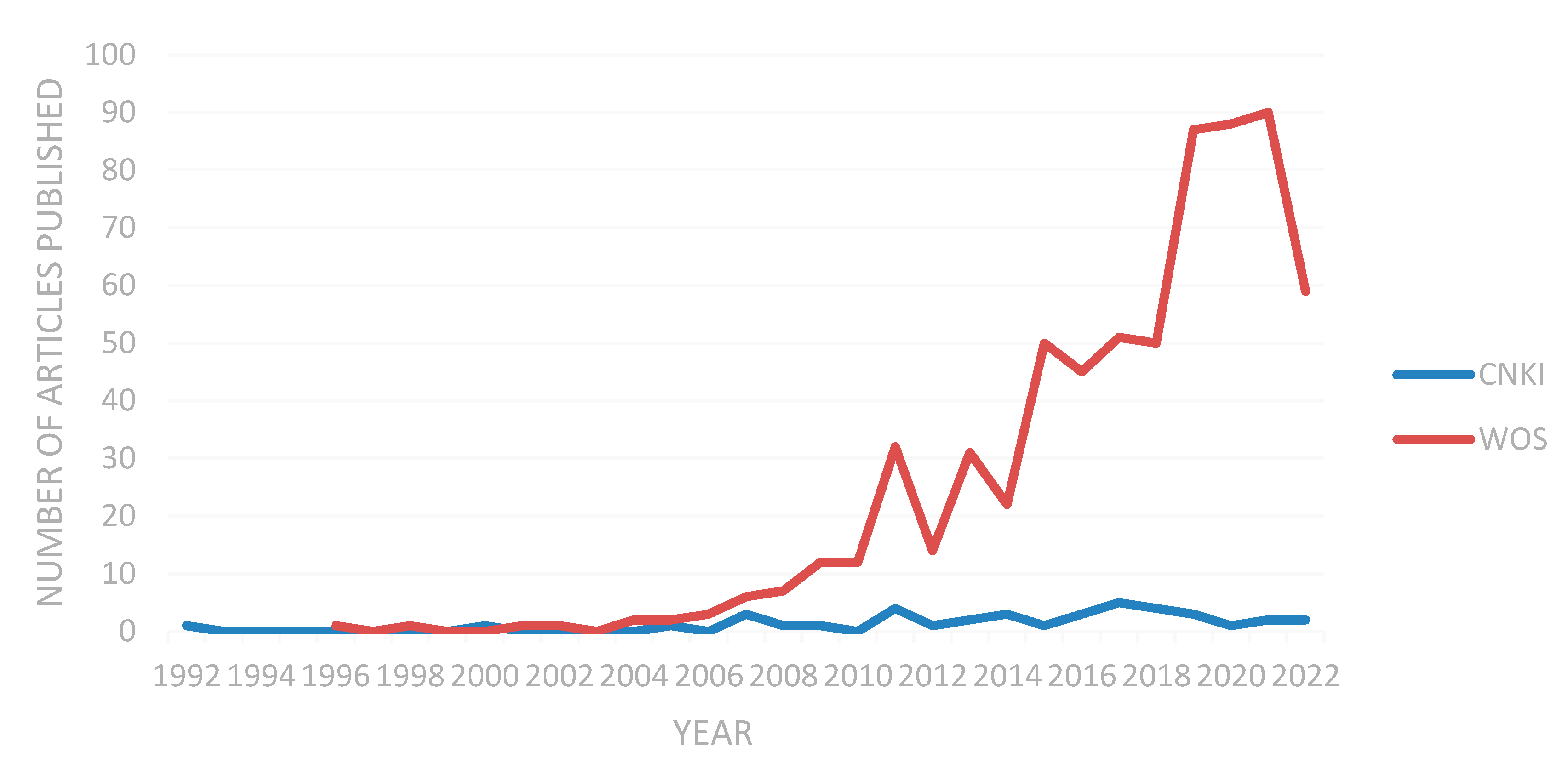
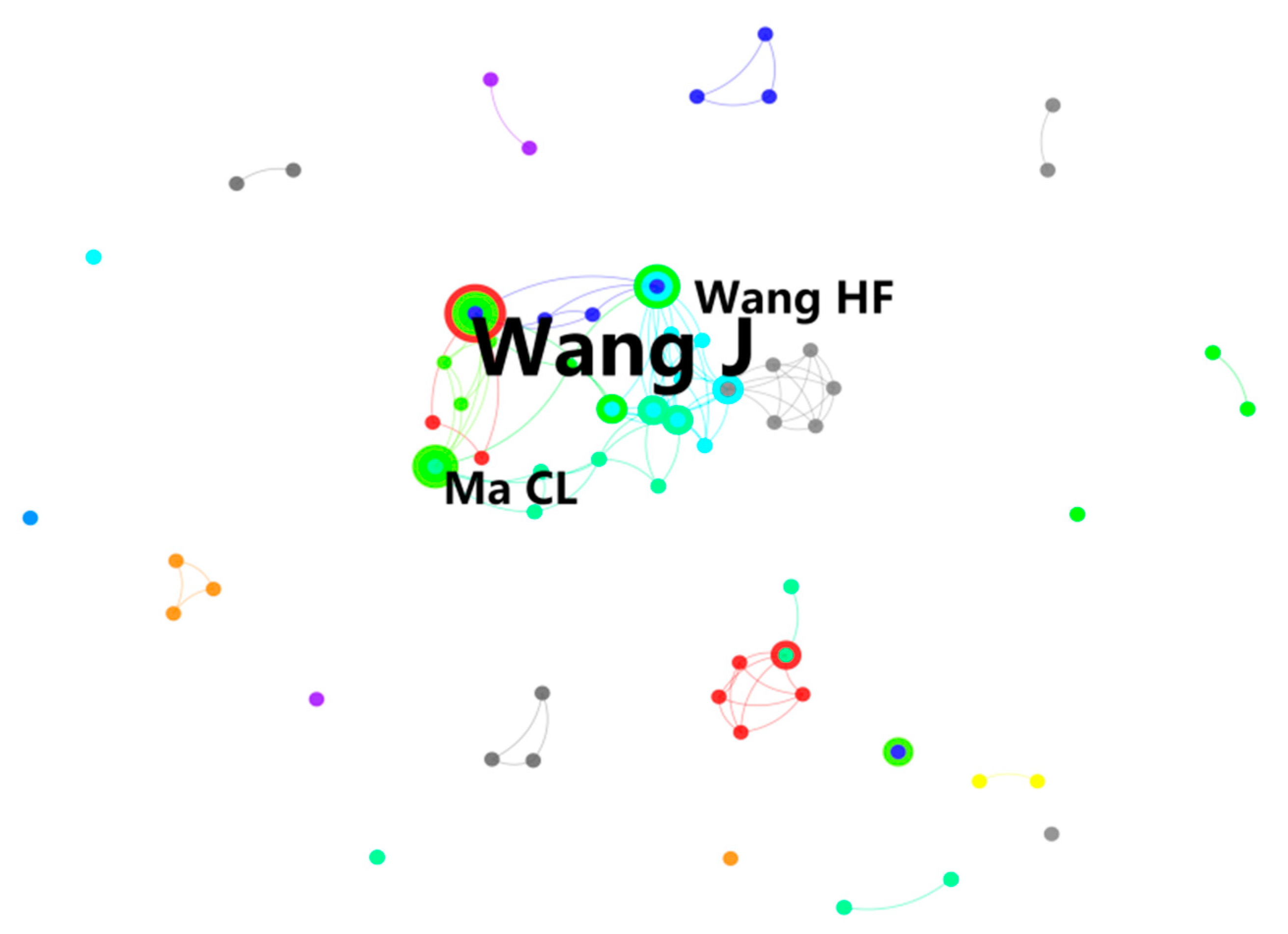
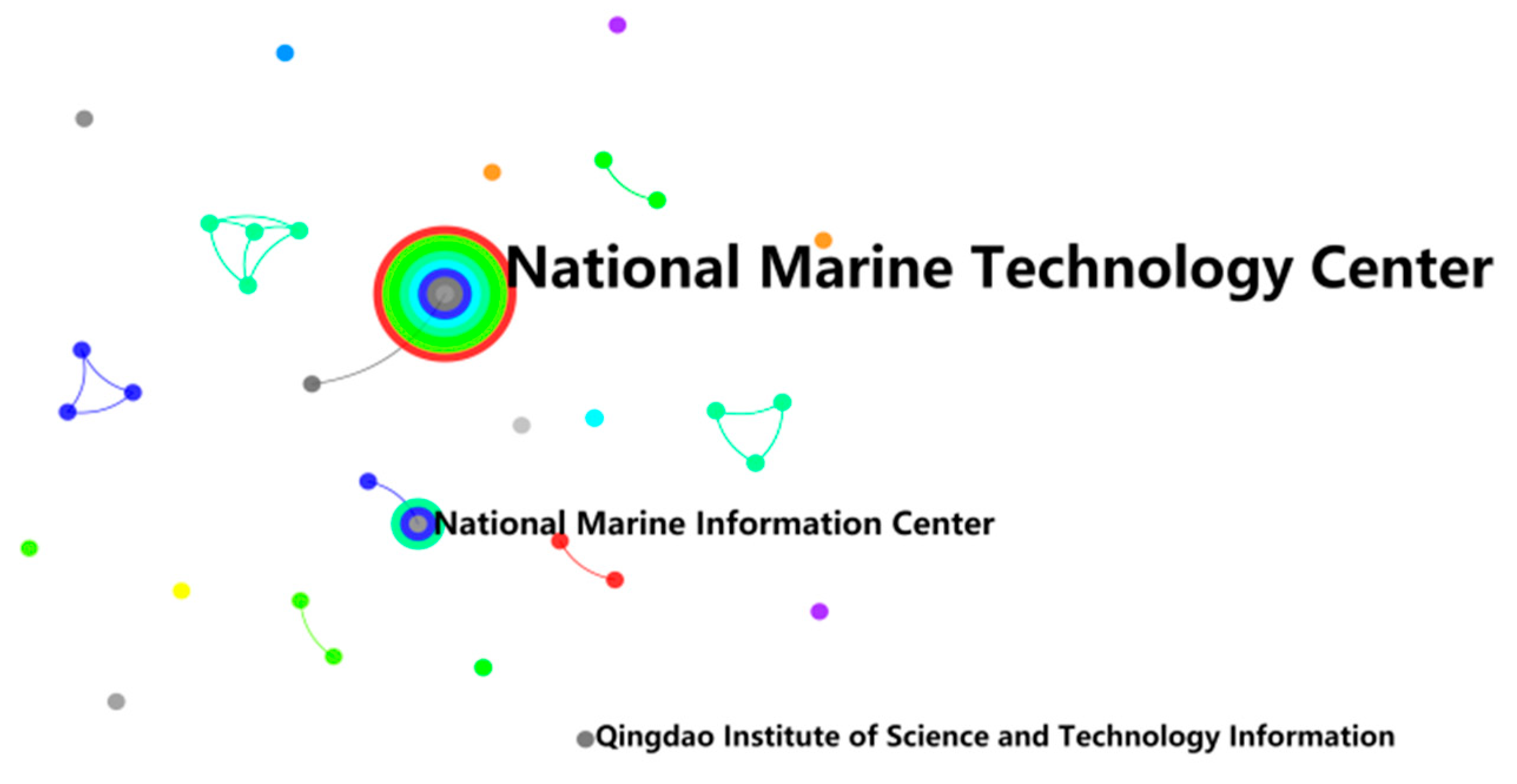
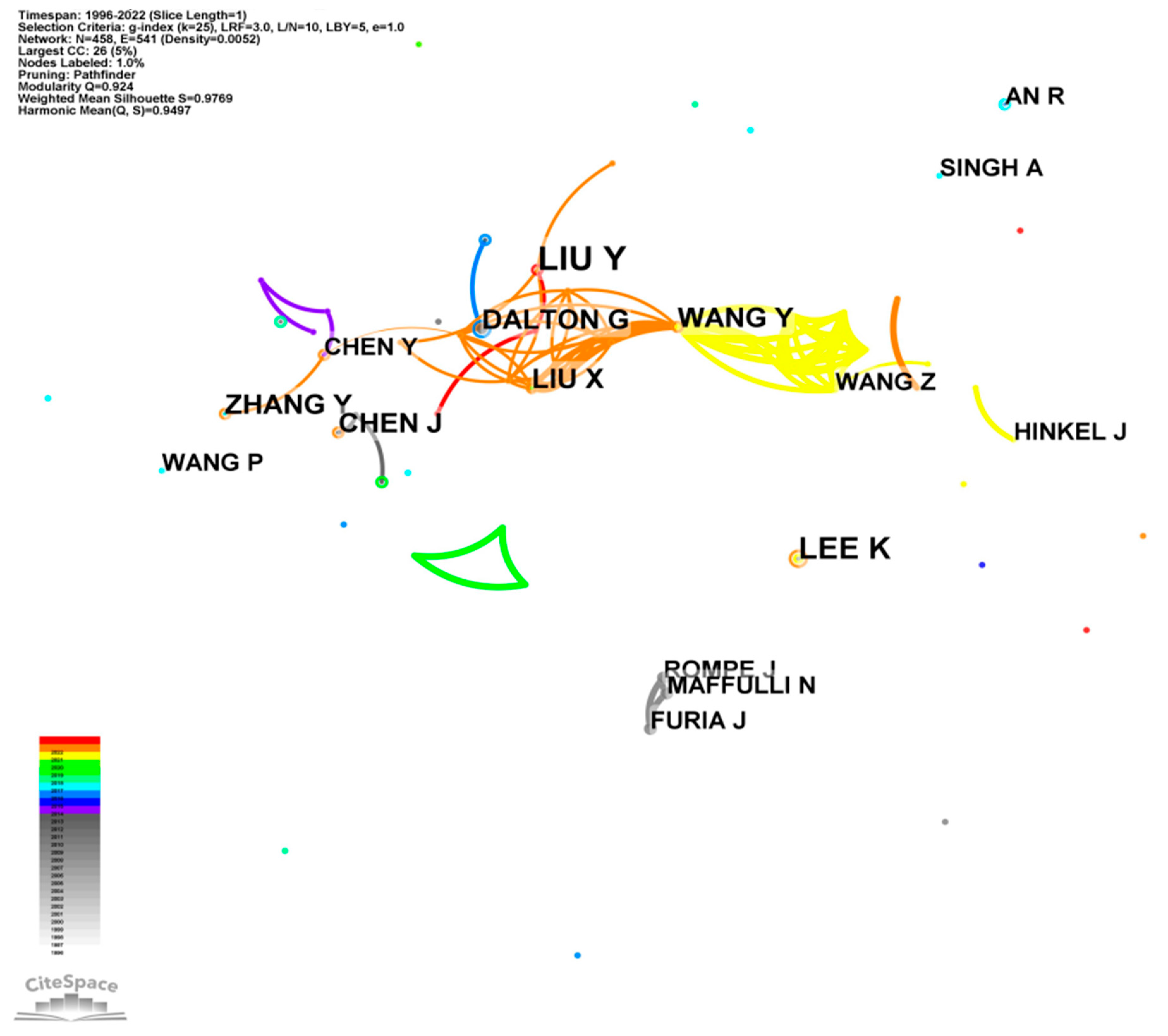
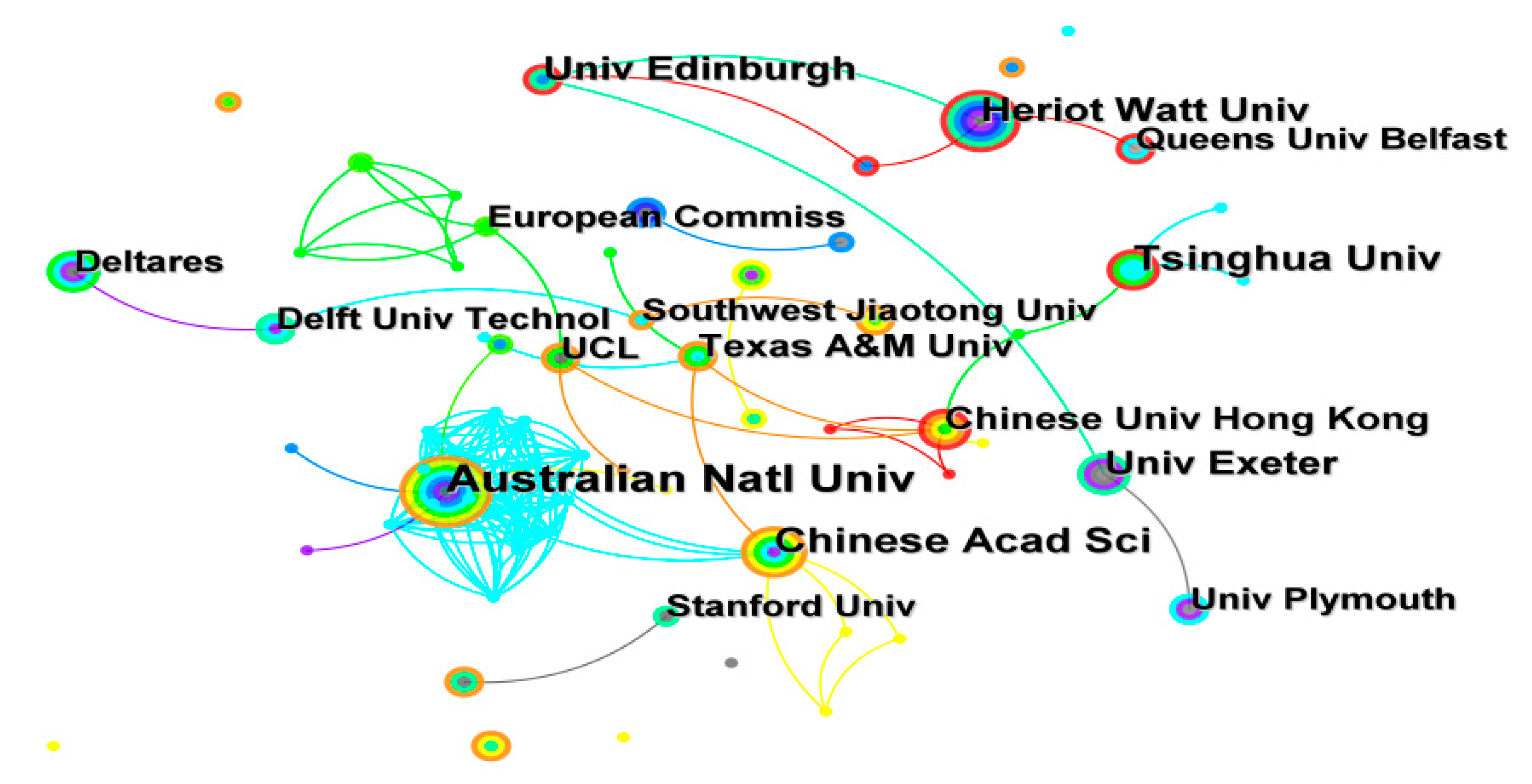
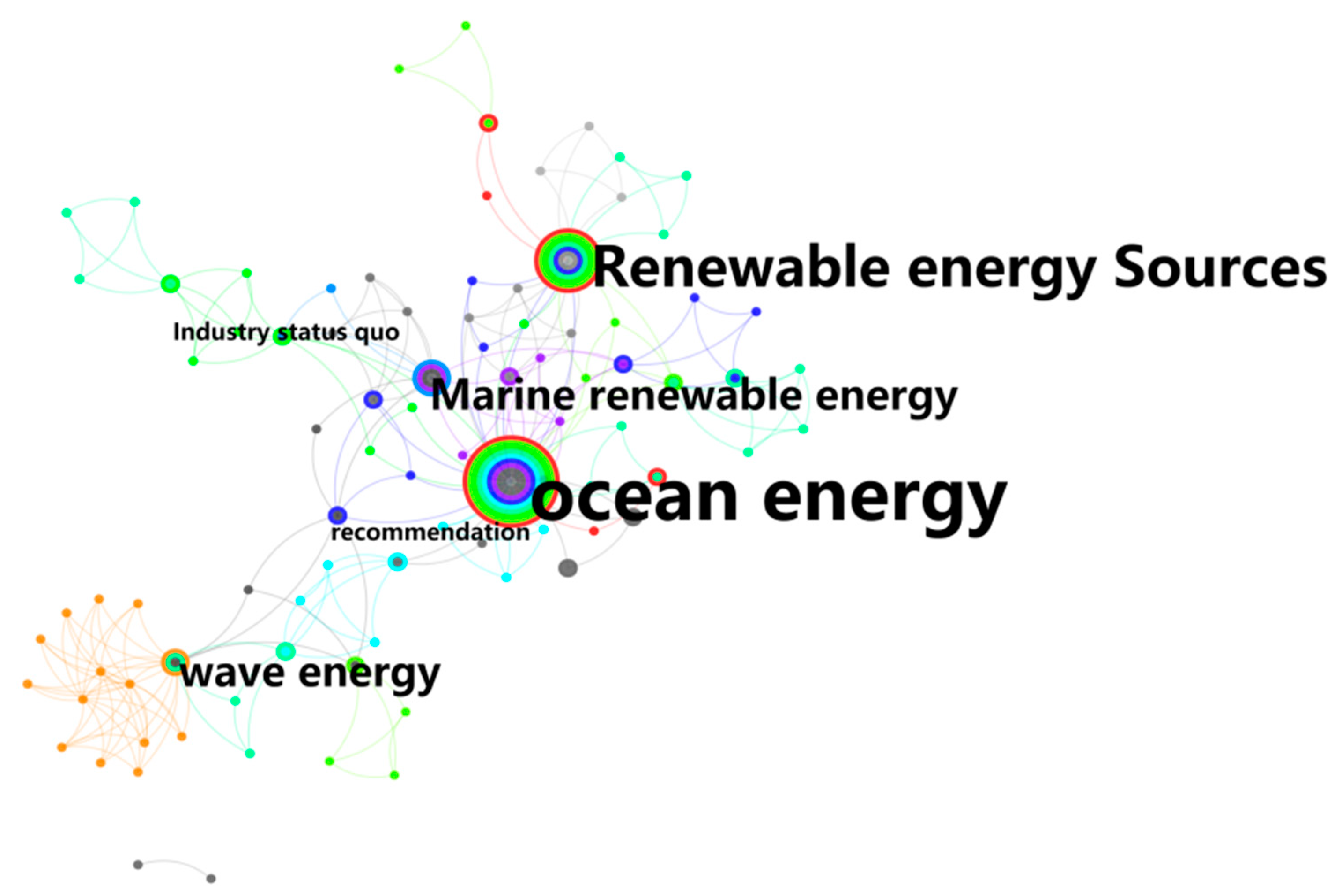

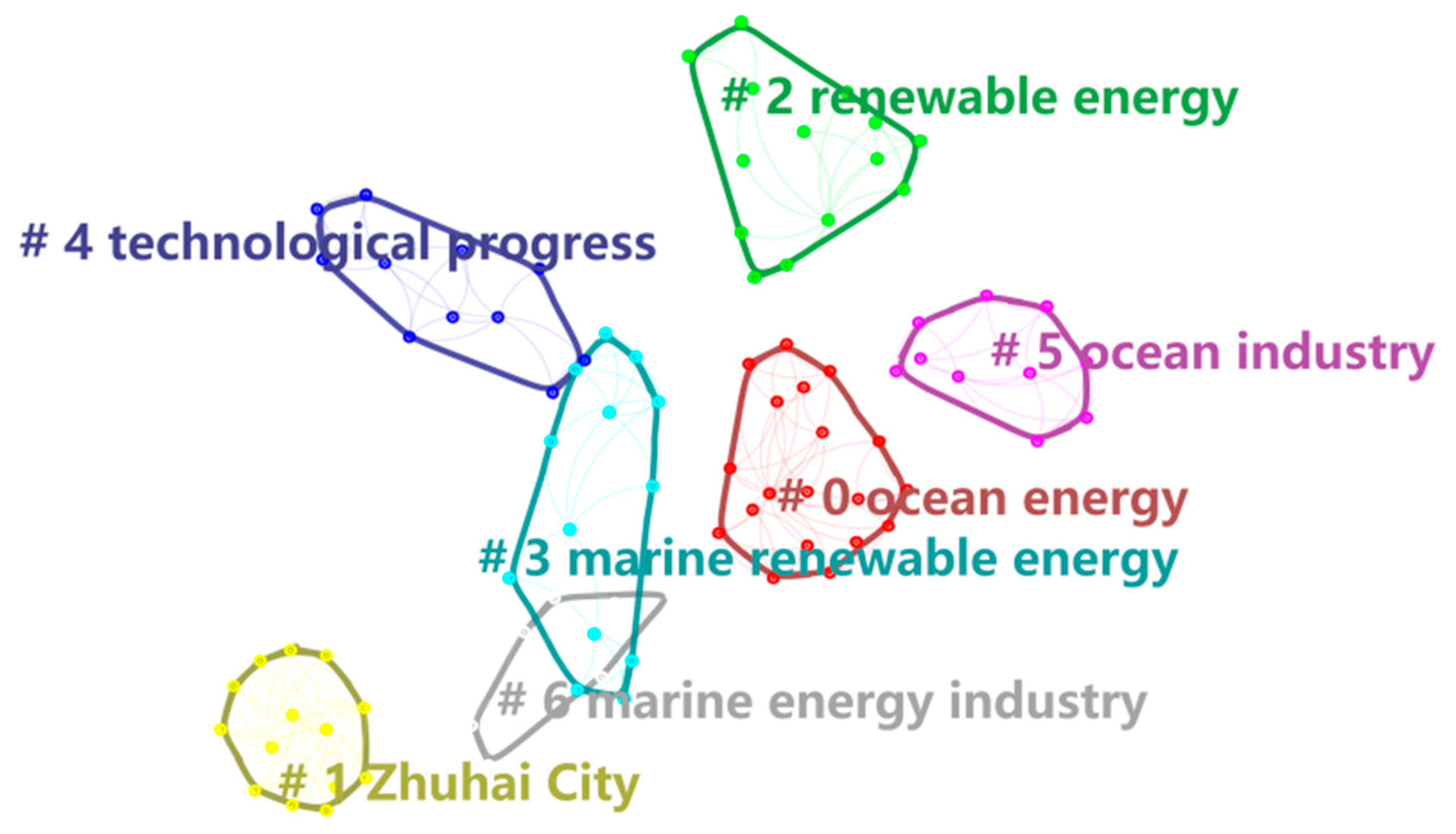
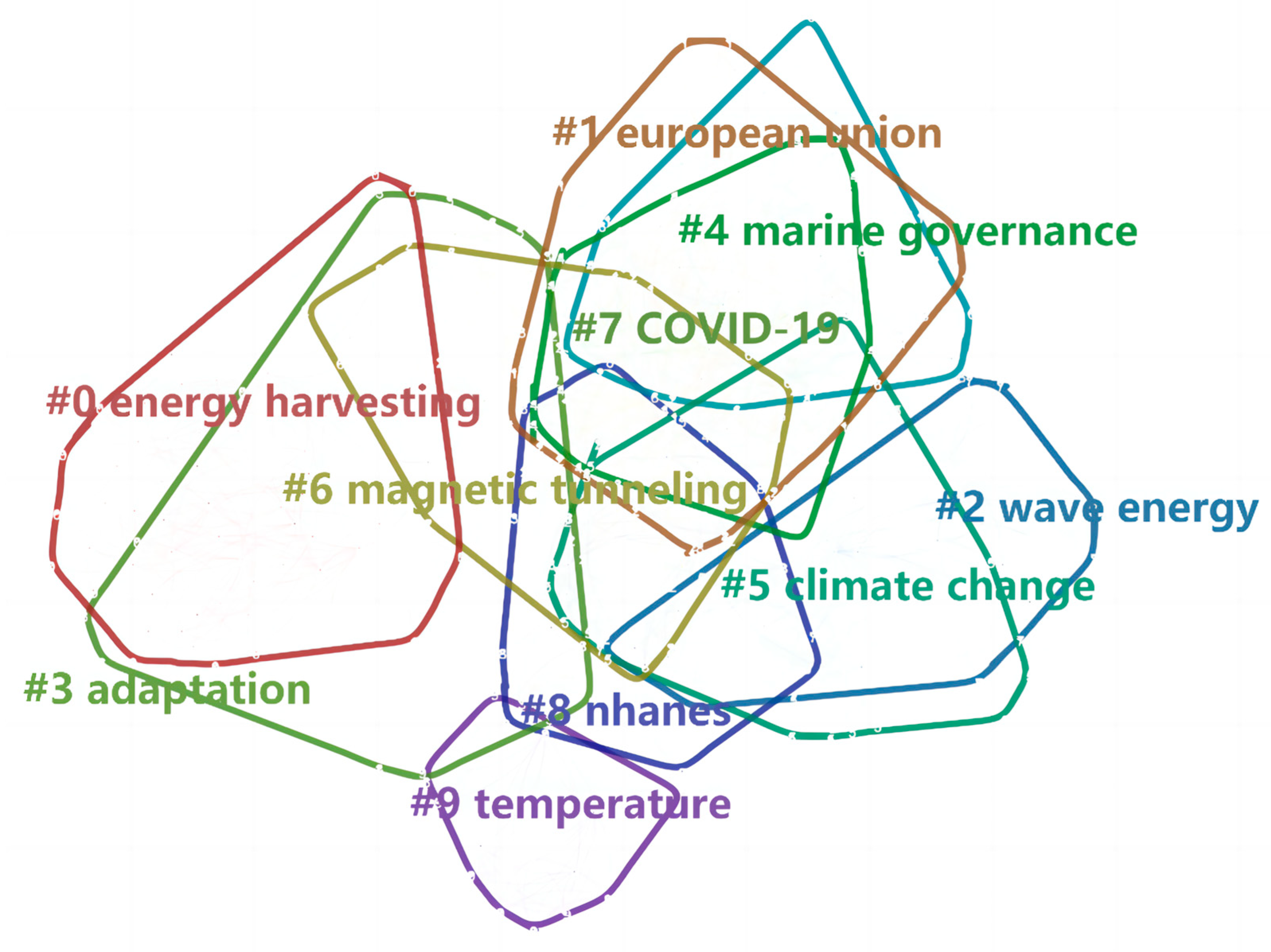
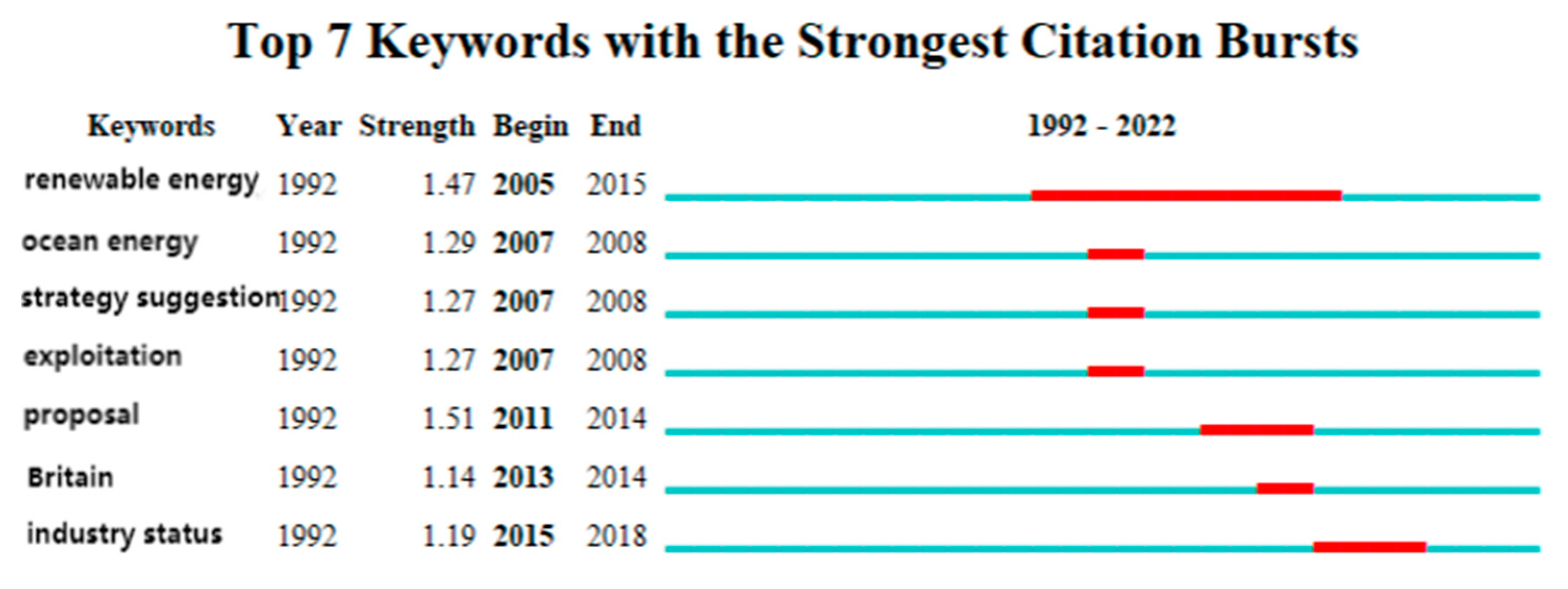
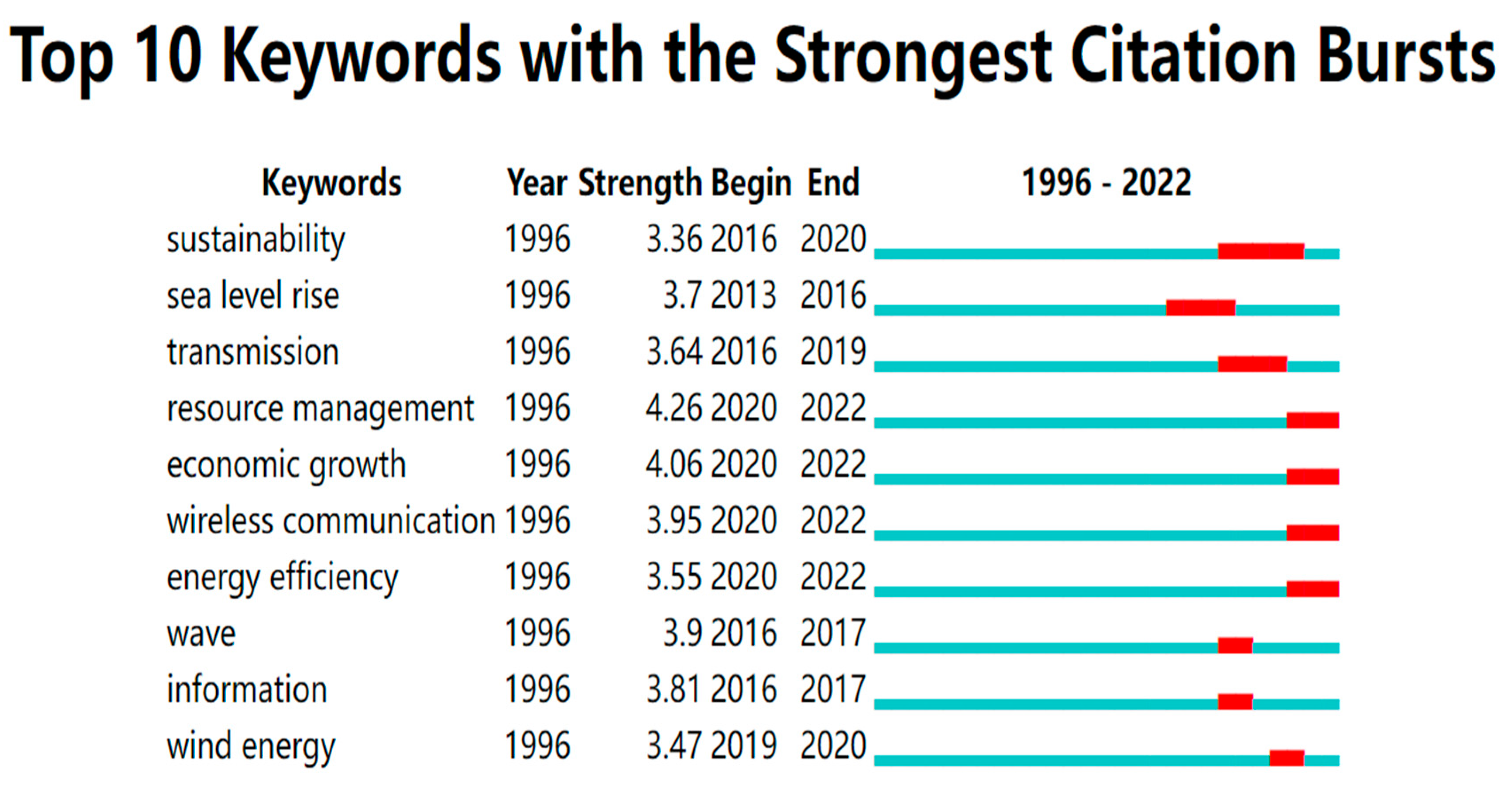
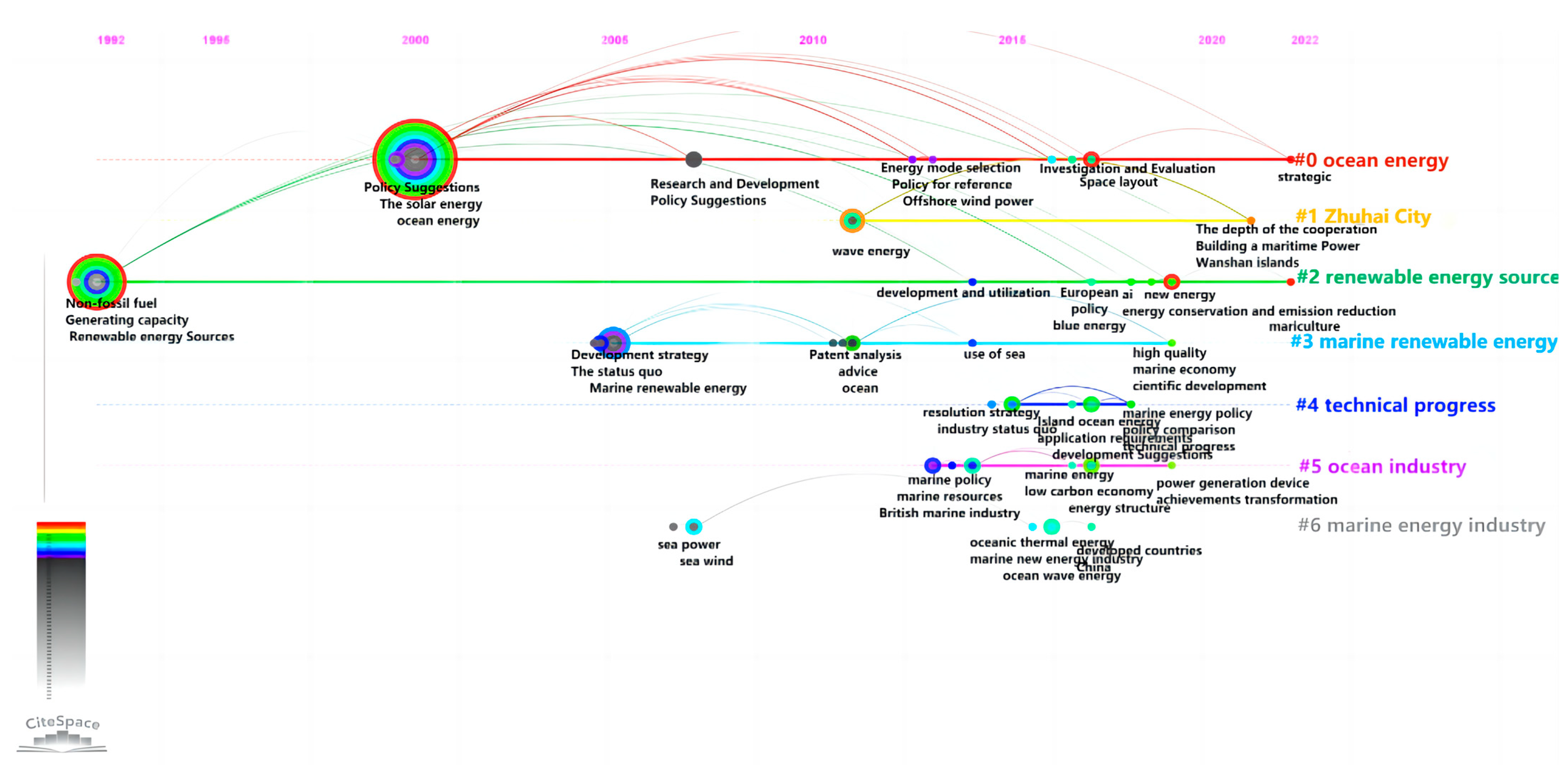
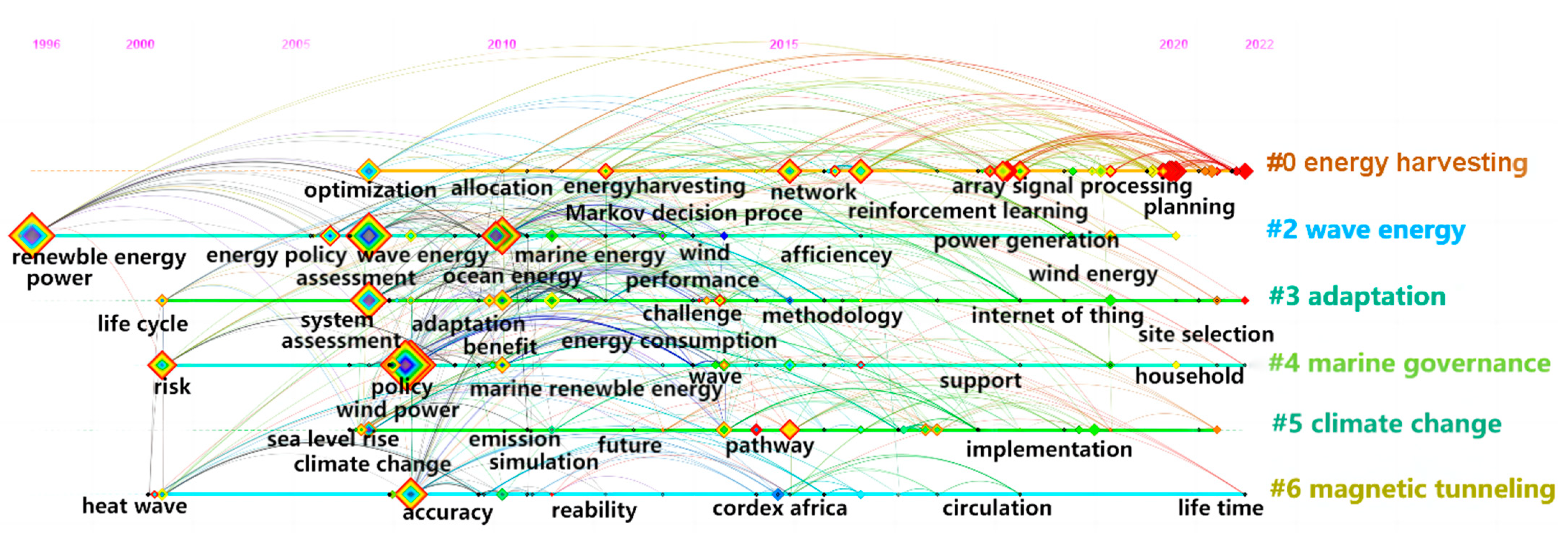
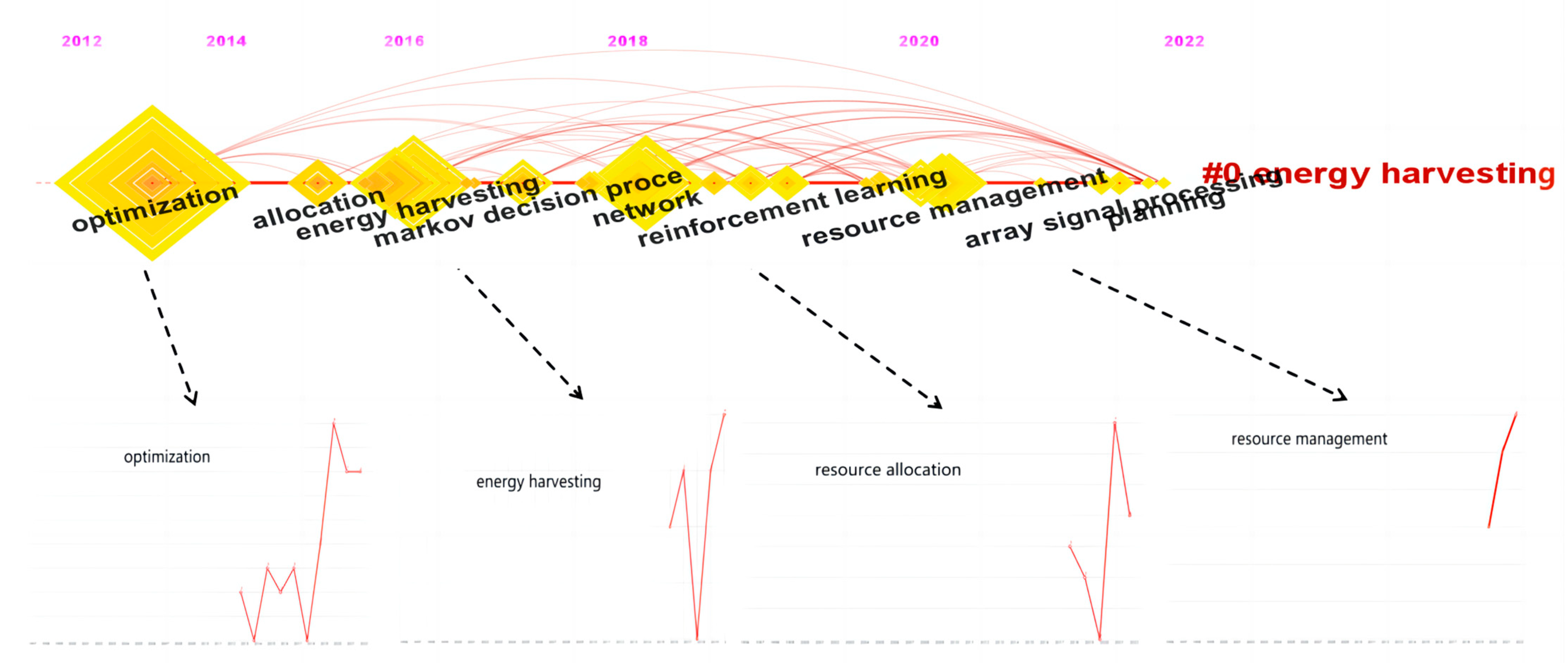
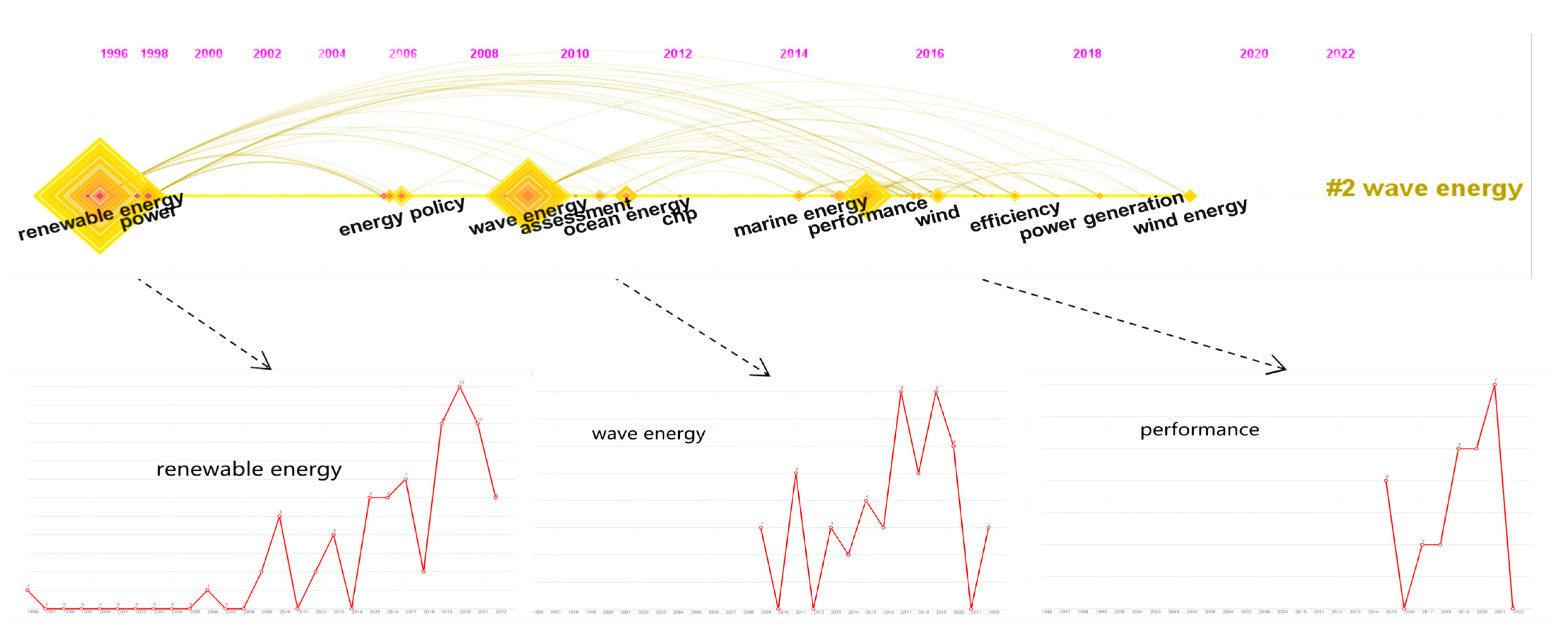
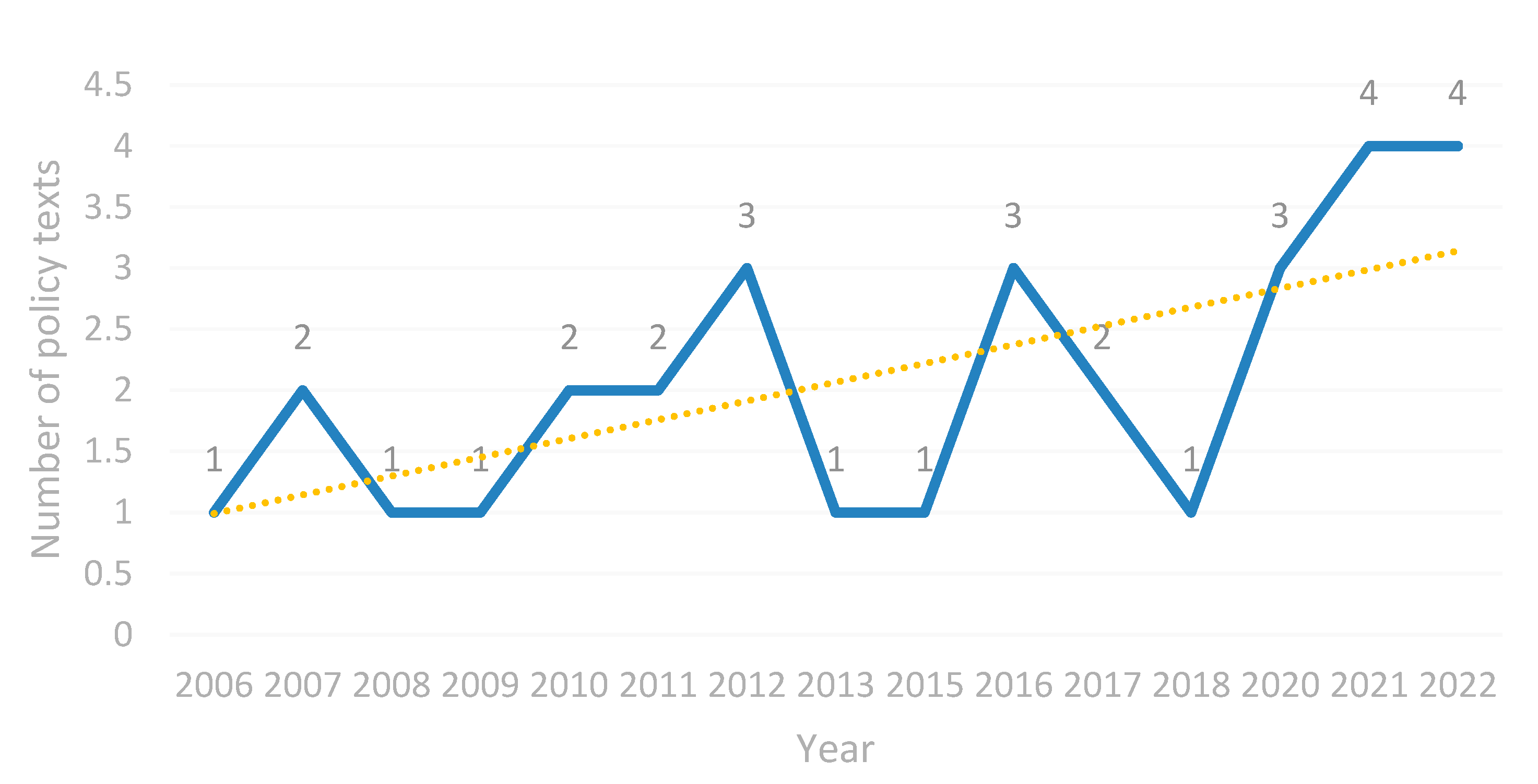
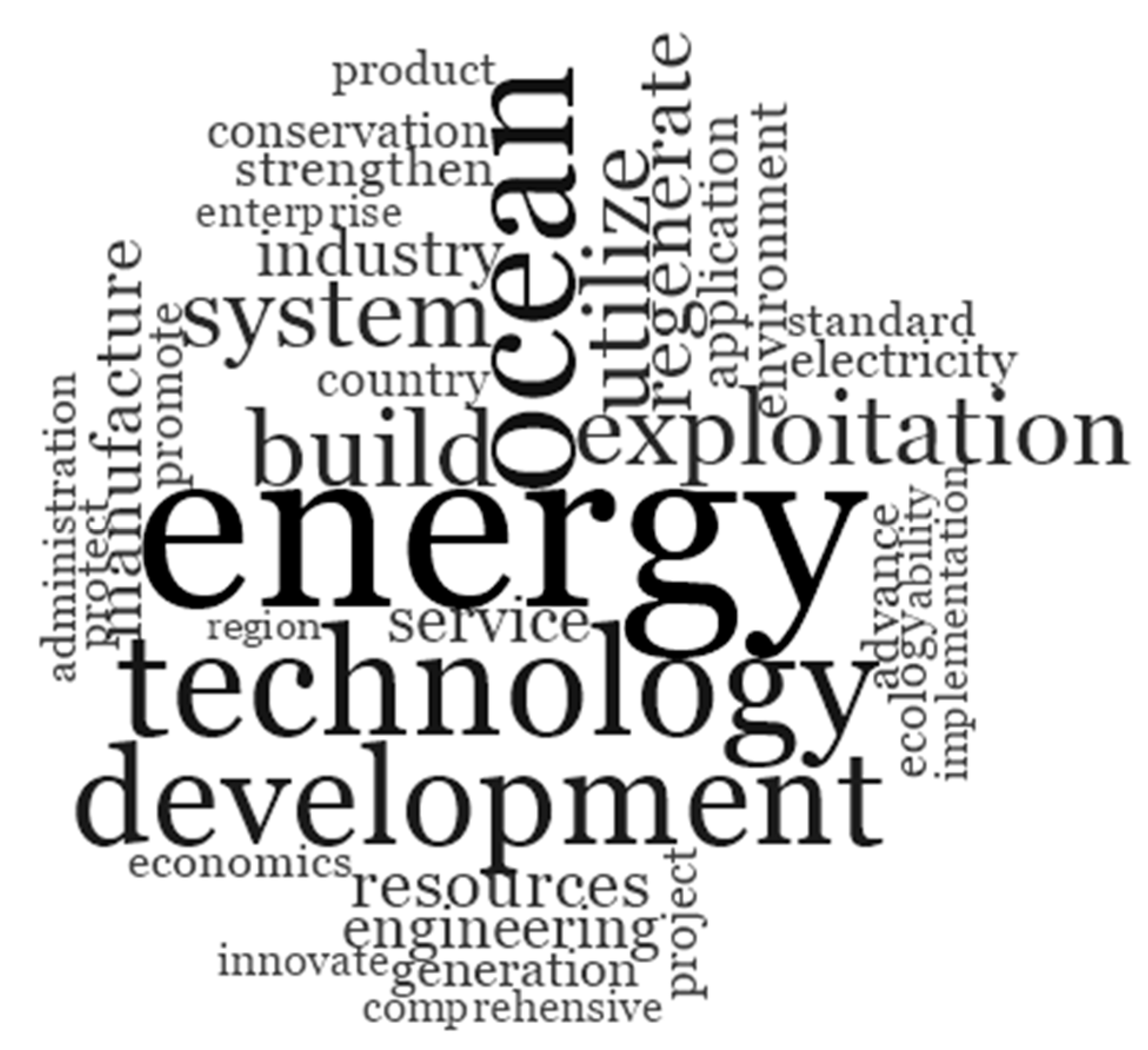
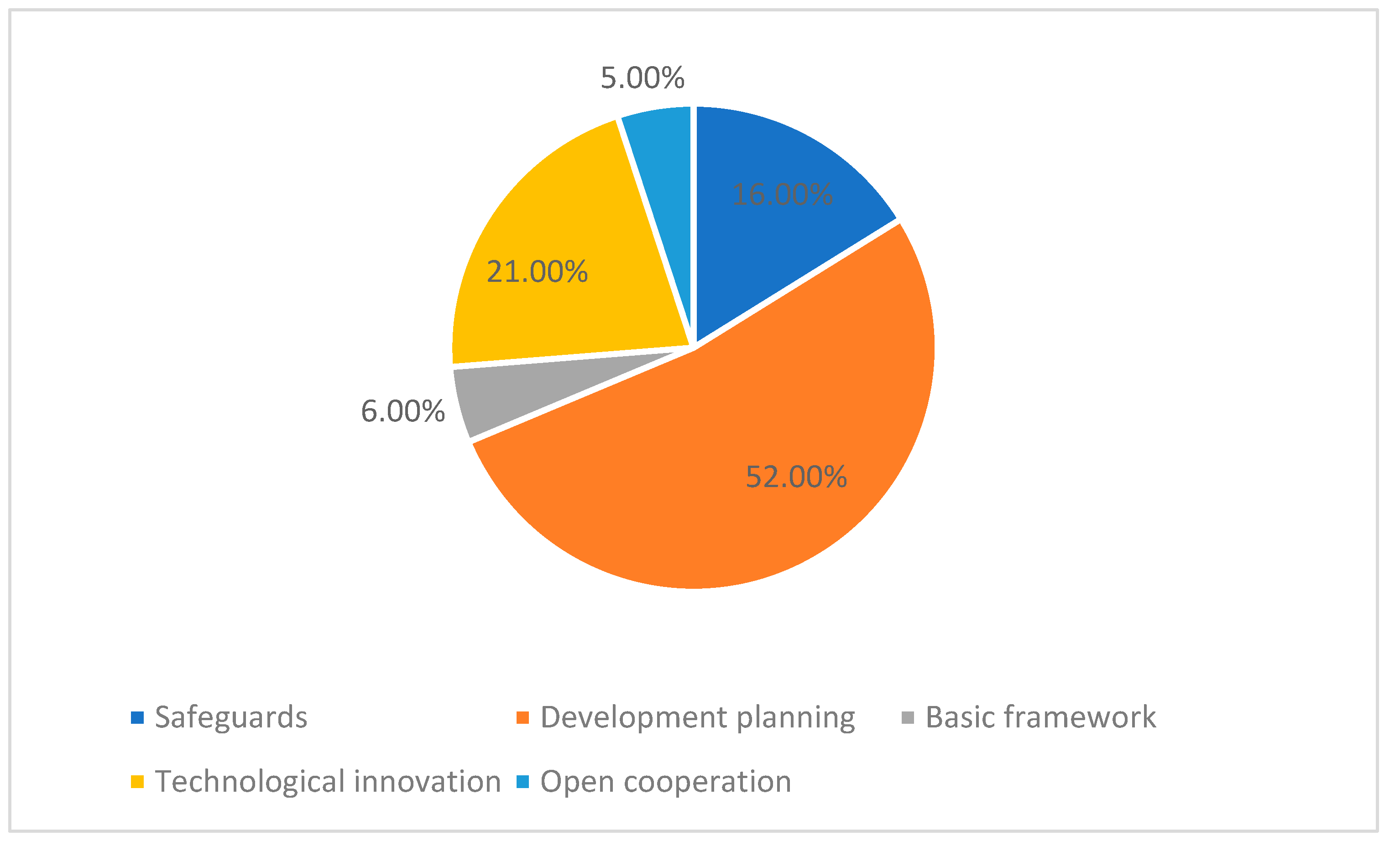
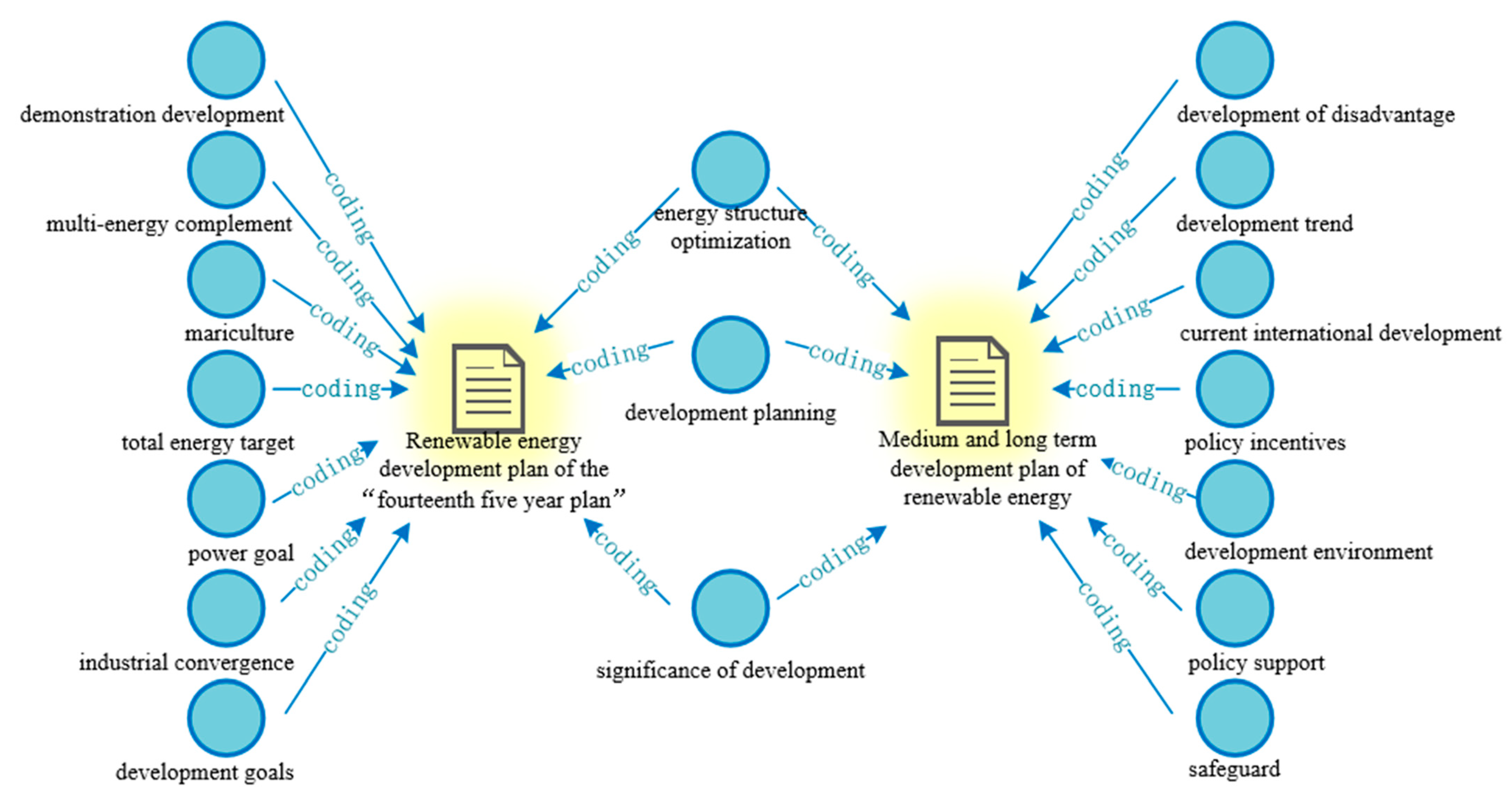
| CNKI | WOS | ||||
|---|---|---|---|---|---|
| Keyword | Frequency | Earliest Publication Year | Keyword | Frequency | Earliest Publication Year |
| Ocean energy | 14 | 2000 | Renewable energy | 74 | 1996 |
| Renewable energy | 7 | 1992 | Climate change | 73 | 2008 |
| Marine renewable energy | 4 | 2005 | Impact | 70 | 2001 |
| Wave energy | 4 | 2011 | Policy | 61 | 2008 |
| Recommendation | 3 | 2011 | Wave energy | 50 | 2009 |
| Industry status quo | 3 | 2015 | Energy | 45 | 2010 |
| Ocean | 3 | 2011 | Model | 45 | 2011 |
| Sea wind | 2 | 2007 | System | 43 | 2007 |
| Research and development | 2 | 2007 | Optimization | 37 | 2013 |
| Energy structure | 2 | 2017 | Management | 28 | 2007 |
| Keyword | Frequency | Centrality | Earliest Publication Year |
|---|---|---|---|
| Climate change | 73 | 0.22 | 2008 |
| Renewable energy | 74 | 0.14 | 1996 |
| Risk | 14 | 0.13 | 2002 |
| Impact | 70 | 0.12 | 2001 |
| Model | 45 | 0.12 | 2011 |
| System | 43 | 0.12 | 2007 |
| Policy | 61 | 0.11 | 2008 |
| Optimization | 37 | 0.1 | 2013 |
| Management | 28 | 0.1 | 2007 |
| Consumption | 13 | 0.1 | 2018 |
| Database | Serial No. | Article | Publication | Year | Cited Quantity |
|---|---|---|---|---|---|
| CNKI | 1 | Strategic Choice for National Adjustment of Energy Structure | Advances in Earth Science | 2000 | 118 |
| 2 | Review of marine energy research and development in China | Ocean Development and Management | 2008 | 67 | |
| 3 | Analysis on research and development of ocean energy in China | Ocean Technology | 2007 | 61 | |
| 4 | Status of domestic and international ocean renewable energy technological development and relevant suggestions | Renewable Energy Resources | 2011 | 51 | |
| 5 | Development status and roadmap of marine power generation technology | Electric Power | 2018 | 32 | |
| WOS | 1 | Providing all global energy with wind, water, and solar power, Part I: Technologies, energy resources, quantities and areas of infrastructure, and materials | Energy Policy | 2011 | 884 |
| 2 | Marine renewable energy: potential benefits to biodiversity An urgent call for research | Journal of Applied Ecology | 2009 | 280 | |
| 3 | Real-World Carbon Dioxide Impacts of Traffic Congestion | Transportation Research Record | 2008 | 278 | |
| 4 | Urban form and climate change: Balancing adaptation and mitigation in the US and Australia | Habitat International | 2009 | 257 | |
| 5 | Linking emission trading to environmental innovation: Evidence from the Italian manufacturing industry | Research Policy | 2015 | 205 |
| Year | Policy Name | Year | Policy Name |
|---|---|---|---|
| 2006 | Renewable Energy Law of the People’s Republic of China | 2017 | Action Plan for Sustainable and Healthy Development of Marine Engineering Equipment Manufacturing Industry (2017–2020) |
| 2007 | Medium- and Long-Term Development Plan of Renewable Energy | 2017 | Three-Year Action Plan for Enhancing the Core Competitiveness of Manufacturing Industry (2018–2020) |
| 2007 | China’s National Program on Climate Change | 2018 | Implementation Opinions on Promoting the High-Quality Development of Marine Economy |
| 2008 | National Science and Technology Planning Outline 2008–2015 | 2020 | Catalogue of Industries Encouraging Foreign Investment (2020 Edition) |
| 2009 | China’s Marine Science and Technology Development Roadmap to 2050 | 2020 | Statistical Investigation System of Marine Economy |
| 2010 | Interim Measures for the Administration of the Special Fund for Marine Renewable Energy | 2020 | Accounting System for Gross Marine Product |
| 2010 | Amendment to the Renewable Energy Law of the People’s Republic of China | 2021 | The 14th Five-Year Plan for National Economic and Social Development of the People’s Republic of China and the Outline of the Long-term Goals for 2035 |
| 2011 | Outline of the National 12th Five-Year Plan for Marine Science and Technology Development | ||
| 2011 | National Marine Function Zoning (2011–2020) | 2021 | Reference Relationship between Strategic Emerging Industry Classification and International Patent Classification (2021) (Trial) |
| 2012 | Report to the 18th National Congress of the Communist Party of China | ||
| 2012 | The 12th Five-Year Plan for National Economic and Social Development of the People’s Republic of China | 2021 | Carbon Peak Action Plan by 2030 |
| 2012 | The 12th Five-Year Plan for national Marine economic development | 2021 | Statistical Classification of Energy Conservation, Environmental Protection and Clean Industry (2021) |
| 2013 | Outline of Marine Renewable Energy Development (2013–2016) | 2022 | Energy Carbon Peak Carbon Neutralization Standardization Improvement Plan |
| 2015 | China Ocean Development Report (2015) | 2022 | Renewable Energy Development Plan of the “14th Five-Year Plan” |
| 2016 | Interim Measures for the Administration of the Special Fund for Marine Renewable Energy | 2022 | The 14th Five-Year Plan for Modern Energy System |
| 2016 | National Plan for Rejuvenating the Sea through Science and Technology (2016–2020) | 2022 | Notice on Preferential Policies for Enterprise Income Tax in Hengqin Guangdong Macao Deep Cooperation Zone |
| 2016 | The 13th Five-Year Plan for the Comprehensive Work of Energy Conservation and Emission Reduction |
| Selective Coding | Spindle-Type Coding | Open Coding | Files | Reference Point |
|---|---|---|---|---|
| Safeguards | Policy support | Policy incentives | 2 | 3 |
| Policy guidance | 1 | 1 | ||
| Financial support | Financial system | 1 | 5 | |
| Guaranteed acquisition of renewable-energy power generation | 1 | 1 | ||
| Tax preference | 1 | 1 | ||
| Government investment | 3 | 3 | ||
| Special fund | 1 | 3 | ||
| Institutional setup | Institutional setup | 1 | 1 | |
| Technological innovation | Technical support | Adapting to natural island environment | 1 | 1 |
| Cost savings | Cost savings | 1 | 1 | |
| Engineering of energy-utilization technology | Productization of marine-energy development | 1 | 1 | |
| Expanding the application field of ocean-energy technology | 1 | 1 | ||
| New product development | Developing equipment to realize engineering and industrial applications | 4 | 5 | |
| R&D and design level | Power-generation technology | 4 | 5 | |
| Breaking through the core technology of wave-energy development equipment | 6 | 8 | ||
| Total installed capacity | 1 | 1 | ||
| Open cooperation | International cooperation | Actively participating in international affairs | 1 | 1 |
| Global ocean governance | 1 | 1 | ||
| Cooperative operation | 1 | 1 | ||
| Technology import | technology import | 2 | 2 | |
| Broadening financing channels | Attracting foreign investment | 1 | 1 | |
| Development planning | Industrial integration | Wave-power supply | 1 | 1 |
| Multi-energy complementation | 3 | 4 | ||
| Mariculture | 1 | 1 | ||
| Development environment | Development basis | 2 | 3 | |
| Development disadvantage | 2 | 5 | ||
| Development trend | 4 | 4 | ||
| Development advantages | 1 | 1 | ||
| International development status | 2 | 5 | ||
| Defining the types of marine renewable energy | 1 | 2 | ||
| Site investigation and resource evaluation | 2 | 2 | ||
| Development goals | Generation target | 2 | 3 | |
| Total energy target | 2 | 2 | ||
| Development significance | Improving marine ecological environment | 1 | 1 | |
| Marine economic strategy | 2 | 2 | ||
| Promoting energy conservation and emissions reduction in marine industry to | 1 | 1 | ||
| optimize the energy structure | 4 | 7 | ||
| Demonstration development | Demonstration development | 6 | 10 | |
| Optimizing layout | Marine-industry layout | 1 | 1 | |
| Ocean spatial layout | 1 | 3 | ||
| Marine regional layout | 4 | 4 | ||
| Basic framework | Marine-function zoning | Marine-function zoning | 1 | 1 |
| Basic connotation | Basic connotation | 2 | 2 | |
| Statistical standards | Statistical standards | 2 | 3 |
| Research Content | Research Conclusions |
|---|---|
| General overview | The quantity and development speed of wave-energy policy research in China are lower than those around the world. |
| The number of core authors in the field of wave-energy policy research in China is small, and there are obvious weaknesses in scientific research cooperation. | |
| Research hotspot | Wave-energy policy research has formed a stable theoretical research theme. |
| Both domestic and foreign studies on wave-energy policy aim at improving the ecological environment, but foreign studies are more detailed in terms of policy risks, policy systems, and policy management than domestic studies. | |
| The change in hot spots of wave-energy policy research in China takes 2007 as the main demarcation point. International hot spots of wave-energy policy research show obvious stages, with 2013, 2016, and 2020 as the cutoff points. | |
| Research vein | China’s wave-energy policy has gone through the initial stage of research and development, and now it has entered a period of rapid development. |
| Foreign wave-energy policy research can be roughly divided into three stages. The first stage is from 1996 to 2004, when wave energy entered the initial exploration stage. The second stage is from 2005 to 2012, when wave-energy policy was rapidly promoted. The third stage is from 2013 to 2022, when the focus of wave-energy research shifted to resource integration and other aspects. | |
| Policy text | The number of Chinese wave-energy policy texts is on the rise as a whole, with policy content gradually being refined, policy tools gradually being optimized, and policy intensity gradually being deepened. |
Disclaimer/Publisher’s Note: The statements, opinions and data contained in all publications are solely those of the individual author(s) and contributor(s) and not of MDPI and/or the editor(s). MDPI and/or the editor(s) disclaim responsibility for any injury to people or property resulting from any ideas, methods, instructions or products referred to in the content. |
© 2023 by the authors. Licensee MDPI, Basel, Switzerland. This article is an open access article distributed under the terms and conditions of the Creative Commons Attribution (CC BY) license (https://creativecommons.org/licenses/by/4.0/).
Share and Cite
Qi, M.; Dai, X.; Zhang, B.; Li, J.; Liu, B. The Evolution and Future Prospects of China’s Wave Energy Policy from the Perspective of Renewable Energy: Facing Problems, Governance Optimization and Effectiveness Logic. Sustainability 2023, 15, 3274. https://doi.org/10.3390/su15043274
Qi M, Dai X, Zhang B, Li J, Liu B. The Evolution and Future Prospects of China’s Wave Energy Policy from the Perspective of Renewable Energy: Facing Problems, Governance Optimization and Effectiveness Logic. Sustainability. 2023; 15(4):3274. https://doi.org/10.3390/su15043274
Chicago/Turabian StyleQi, Meng, Xin Dai, Bei Zhang, Junjie Li, and Bangfan Liu. 2023. "The Evolution and Future Prospects of China’s Wave Energy Policy from the Perspective of Renewable Energy: Facing Problems, Governance Optimization and Effectiveness Logic" Sustainability 15, no. 4: 3274. https://doi.org/10.3390/su15043274
APA StyleQi, M., Dai, X., Zhang, B., Li, J., & Liu, B. (2023). The Evolution and Future Prospects of China’s Wave Energy Policy from the Perspective of Renewable Energy: Facing Problems, Governance Optimization and Effectiveness Logic. Sustainability, 15(4), 3274. https://doi.org/10.3390/su15043274









